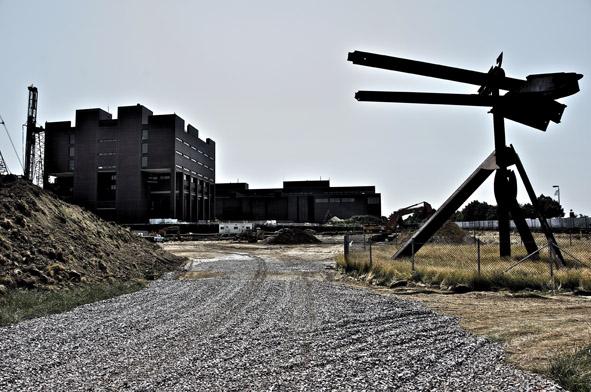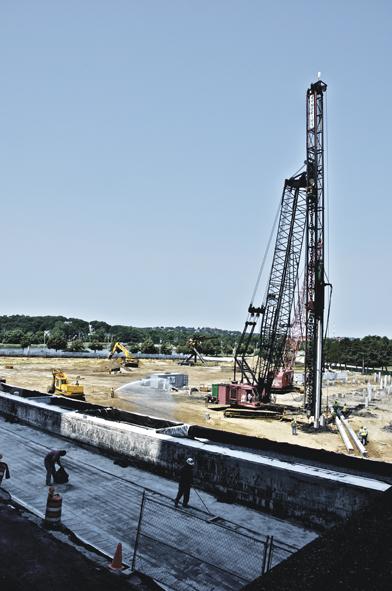Since the first classes called attendance on the Columbia Point
Campus in 1974, thousands of students have enrolled and earned
their degrees within the same redbrick buildings. Now, 37 years
later, the loud bangs of pile-driving echoes in the Peninsula and
Harbor Point apartment complexes. These piles will form the basic
foundation of Columbia Point Campus’s first new academic building:
the Integrated Sciences Complex.
The 220,000 square foot, 6 story, 155 million dollar Integrated
Sciences Complex (ISC) is expected to be open for business by the
beginning of Fall term, 2013. Designed by architect Goody Clancy,
the building is being erected at the entrance of Columbia
Point.
The Division of Capital Asset Management (DCAM) and the UMass
Building Authority are responsible for overseeing the construction
of new facilities on the UMass Boston campus. Recently, DCAM and
the UMass Building Authority signed a Project Labor Agreement (PLA)
that requires that construction be performed by union
laborers.
The goals for the PLA are that 50 percent of the people working on
the ISC are Boston residents, 25 percent minority and 10 percent
female, thus ensuring mutual benefit to the UMass System, the
State, and local workers.
Chancellor Keith Motley looks forward to overseeing the project
that will usher in a new academic building. “The Integrated
Sciences Complex represents a significant step forward in our
continued commitment to provide access to high-quality education
for our students.”
UMass Boston junior Tyler O’Brien, an environmental earth and ocean
science major and leader in the Student Success Center says: “not
only will the new building bring students top of the line research
and lab equipment, it will also allow students to look into the
future of cancer research.”
Indeed, the ISC will host a top of the line personalized cancer
therapy research center to aid in the school’s ongoing mission to
join real-life research with classroom education. UMass’
partnership with Dana Farber and its implementation of new,
high-tech cancer research facilities in the ISC demonstrate an
unfaltering dedication to science, medicine, and the advancement in
knowledge of its students.
Tyler added, “The money used for the Integrated Science Center is
keeping UMass Boston true to its word as one of the top science
research universities in the state. Now, future students will have
the best technology and professors right in front of them.”
Beyond the world-class personalized cancer therapy research center,
the ISC will also boast both wet and dry research labs, a
developmental sciences research center, the Infant Cognition Lab,
and an “interdisciplinary sandbox teaching lab.”
The goal of the ISC’s architectural design is laid out in a
framework written in early 2009. That goal is “to make doing
science a visible part of the learning environment; to enhance the
humanity and aesthetics of the campus including connection to our
beautiful waterfront; to make our new space adaptable and flexible
so that it continues to serve us well for decades to come.” There
has also been a great deal of discussion regarding a “sustainable
design.”
Holly Sutherland works closely with Ellen O’Connor on Master Plan
and Construction Communications. In an interview she elaborated on
some of the lesser-known but important ongoing projects
“Alongside the construction of the ISC, a little known but very
important building UMass Boston’s utility plant is getting a much
needed new roof and waterproofing improvements. Simultaneously
occurring is the creation of a new building known as the Medium
Voltage Switchgear Electrical Building is being created to house
the campus’ most vital electrical equipment. Wheatley’s roof has
been adorned with 350 solar panels expected to generated 10,000
dollars worth of green energy annually.”
The 25-year plan promises another new “general academic building”
scheduled to begin construction in 2012, new athletic and parking
facilities, additional educational buildings, and even residential
premises for students wishing to live on campus. Additionally,
improvements will be made to the Harbor Walk, which encircles the
school, as the shores there have undergone much erosion. UMass
Boston’s Campus will also be the site of the Edward M. Kennedy
Institute for the United States Senate.
Funding for the ISC specifically has been provided by the state
funded Higher Education Bond Bill, which contributed $100 million
dollars, which will be paid back to Massachusetts. The UMass Boston
Building Authority kicked in an additional $47 million. $5 million
came from Mass Development funds and $3 million University
funds.






















































